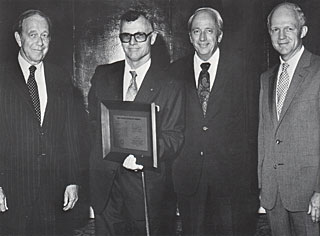
 |
Search | FAQ | US Titles | UK Titles | Memories | VaporWare | Digest | |||||||
| GuestBook | Classified | Chat | Products | Featured | Technical | Museum | ||||||||
| Downloads | Production | Fanfares | Music | Misc | Related | Contact | ||||||||
| Memories of VideoDisc - Who's Who in VideoDisc | ||||||||||||||

Thomas Stanley (holding plaque in above photo) was a solid-state engineer at RCA Laboratories in the 1950's. In 1959 William Webster appointed him as a dual group head in both the Systems Research Laboratory and the Electronics Research Laboratory. Extrapolating from some signal-to-noise ratio discussions that William Webster and Harry Olson had earlier engaged in, Stanley's group in 1960 calculated the potential for storing and retrieving information from a vinyl disc using a form of information storage known as electrical capacitance - the CED concept ultimately adapted for the RCA VideoDisc system. Thomas Stanley concluded that video could be stored on such a disc if signal elements of sufficiently small size could be engraved in its surface. But the technology to accomplish this did not exist in 1960.
Other priorities at RCA Labs delayed further investigation of the CED concept until 1964. At the RCA Laboratories spring directors' meeting that year, four information research projects were modestly funded, one based on magnetic tape and the other three (which came to be known as Discpix, Photopix, and Holopix) based on non-magnetic media. The Discpix team headed by Eugene Keizer took up where Stanley left off in 1960, and the team was greatly complemented when
Jon Clemens joined the project in 1965.
In 1966, William Webster became Vice President of Materials and Device, and Thomas Stanley joined the new Business Evaluation staff. In 1968, Stanley became director of the newly formed Consumer Electronics Laboratory after Webster became President of RCA Laboratories. Having these two proponents of the capacitive encoding concept in powerful management positions allowed the Discpix project to survive the difficult basic research stages of the late 1960's. For his fundamental investigation of the CED concept, Thomas Stanley was awarded US Patent No. 3783196 on January 1, 1974. This was one of the first three CED patents filed on March 22, 1971, ten years to the day before the market introduction of the RCA VideoDisc system.
At the recent David Sarnoff Awards presentation (pictured above) RCA Chairman Thornton F. Bradshaw, left, presented a special plaque to Thomas O. Stanley, Staff Vice President, Research Programs, honoring his early contributions to RCA's VideoDisc developments. The plaque depicts one of Stanley's early patents which led to today's VideoDisc. Mr. Stanley was cited as "a visionary who, not only foresaw the CED videodisc system long before its time, but provided the technical encouragement and management support necessary to bring that vision to a reality." William M. Webster, Vice President RCA Laboratories, and William C. Hittinger, right, Executive Vice President, Research and Engineering, attended the presentation.
- July/August 1981 RCA Radiations
WASHINGTON, D.C. - The tiny town of Oxford, Maryland ranked second only to Bethesda in the amount residents sent to the Clinton Legal Expense Trust last year, thanks to a pair of $10,000 contributions from brothers Thomas and Edmund Stanley.
The Stanleys were two of only three people in Maryland to send the maximum allowable contribution to the trust. And the brothers said they have already sent in new $10,000 gifts for 1999.
"I have tremendous respect for President Clinton and the constructive role he has played in many areas -- the environment, peace, certainly handling of the economy," said Thomas Stanley. He said he wants to do "whatever I can do to help him avoid the distractions of the unfortunate developments of the last few years."
Edmund Stanley said he contributed because he has "always been a very strong supporter of the president and Mrs. Clinton. "It's a shame that a presidency generates such unbelievably large legal bills," he said.
The brothers retired to Oxford after long corporate careers, Thomas with RCA in Princeton, N.J., and Edmund with Bowne & Co. Inc., a New York financial documents company where he was chief executive officer for many years.
Both brothers said they are Democrats who regularly give to political candidates, although Thomas Stanley said his gifts are "not ordinarily of that ($10,000) level."
Federal Election Commission filings show that in 1998, Thomas Stanley gave a total of $16,400 to the Democratic party and the re-election campaigns of Democratic Sens. Patty Murray of Washington and Carol Moseley Braun of Illinois.
Edmund Stanley and his wife, Jennifer, gave $29,675 to the Democratic party and a wide variety of candidates.
Both brothers said they discussed their support for the president but did not deliberately coordinate their giving.
"I see my good brother Ted almost daily, or certainly three or four times a week," Thomas Stanley said. "When this first developed, which of us first asked the other (about it), I don't know."
Like his brother, Thomas Stanley mentioned the first lady as part of the reason for his support of the Clintons' legal expense trust.
"Also in my motivation is the tremendous regard I have for Mrs. Clinton," he said. "This goes to help her with some of her travails too .... I think she's a real contributing factor in the welfare of the country.
"Principally, I'm a Democrat from my youth," Thomas Stanley said. "The Democrats have consistently, in my view, been more constructive in what they have done for the country."
- March 5, 1999 Capital News Service Story
Oxford, Maryland - Thomas Osborne Stanley, 91, died on January 14, 2019 at his home in Oxford, MD. Born in Orange, New Jersey, he was the younger son of Edmund Allport Stanley and Emily Hasslacher Stanley.
After attending public schools in South Orange, he went to The Lawrenceville School, graduating in 1945. He served in the U.S. Navy from 1945 to 1946, then attended Yale University, earning a BE and ME in electrical engineering. In 1951, he and Nanette Lee Grodnick of Pelham, New York were married.
Mr. Stanley worked at RCA Corporation's David Sarnoff Research Center in Princeton, New Jersey for his entire career, beginning in 1950. RCA sponsored a 1958/9 sabbatical at Cambridge University, England, with Lee and family, where he studied with computer pioneer Maurice Wilkes. He had a walk-on part at the debut of color television, happily contrived the world's first transistorized pocket radio, and was midwife at the birth in the early 1960's of the MOS transistor - the core component of microprocessors. He predicted that "the geometry and simple fabrication of these devices will someday permit integration of thousands on a single wafer." In research management, he held titles of Staff Vice-President, Systems Research and Staff Vice-President, Research Programs, including responsibilities for laboratories in Zurich and Tokyo. He was issued 14 patents in the fields of color television, transistor circuits, video disc systems and flat-panel television displays.
Tom and Lee made their homes in Princeton and in Mantoloking, NJ, and in Manhattan, before moving to Oxford in 1992. He was engaged with civic organizations both in Oxford and further afield, including Washington College's Starr Center for the Study of the American Experience, the Chesapeake Bay Foundation, the Maryland ACLU, and the Southern Poverty Law Center. He was a founding contributor to the National Constitution Center in Philadelphia.
In his wallet he carried a hand-written card stating: "Listen to diverse voices / Seek new ideas / Embrace variety / Resist stereotypes / Respect diversity / Explore outward / Educate yourself."
Mr. Stanley was predeceased by a daughter, Bridget Alexandra; a son, Mark Raoul; his wife Lee; and brother, Ted. He is survived by two sons: Tom, Alex; a daughter, Susan; two grandchildren: Daisy, Vishveshvara; and six nephews and nieces.
A memorial celebration will be held in Oxford in May.
- January 14, 2019 The Star Democrat Obituary
Search for patents issued to Thomas Osborne Stanley.
If you have some additional information to supply on Thomas Stanley, feel free to submit the form below, so your comments can be added to this page.
Send your comments in email via the Contact page